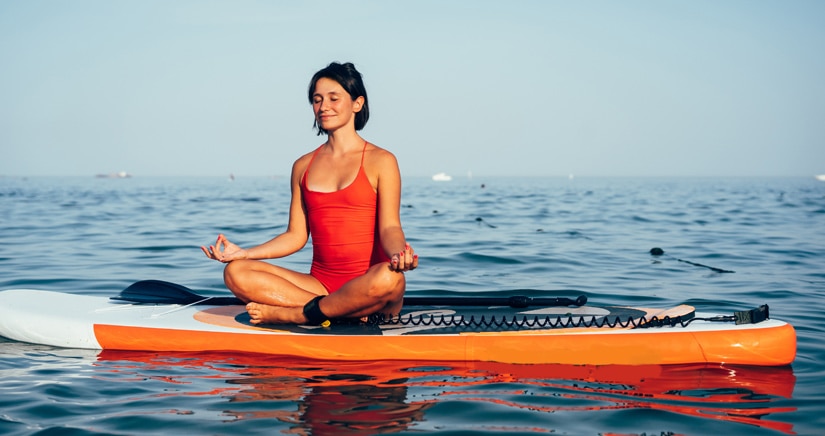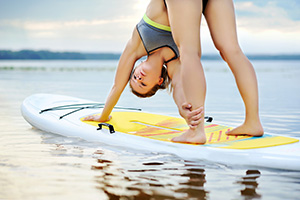It is easy to see why anyone would think that paddle board yoga is hard.
SUP yoga poses are not easy on land, some of them take lots of practice to master.
Now imagine doing them on a paddle board, on a body of water. How are you supposed to do a headstand with your yoga mat swaying under you? Maybe you think it will end up being more of a swimming session than a SUP yoga session.
So how hard is paddle board yoga?
Well, to answer your question:
Key Takeaways
- SUP yoga is harder than regular yoga but not as hard as many people imagine.
- You will not be able to move fast, more so when transitioning from one pose to another.
- Expect to use more muscles than you would on land. Paddle board yoga is a full-body workout and almost every muscle in your body will be put to use.
- A good paddle board makes it easier to learn. Yoga boards should be wide because wider SUPs are generally more stable.
- You can wear what you want as long as it is comfortable and quick-drying.
Is SUP Yoga Hard?
If you compare it to yoga on land, then yes, it can be a little hard.
Unlike dry land, a paddle board is constantly moving. You need to be more mindful and put more effort when practicing yoga on the water.
But it is also not as hard as many people imagine. The good thing about SUP yoga, and yoga in general, is that you don’t have to force anything. You can just go with the flow according to your ability.
With time, your skills will get better.
One thing we can promise is that you will love the experience.
Here, we’ll discuss a few things that SUP yoga beginners should know.
RELATED: Read our article about the best inflatable yoga paddle board options in 2024.
What to Expect When Doing Paddle Board Yoga
Expect your SUP yoga sessions to be a little different, especially if you’ve been practicing on dry land. You will not be able to move fast, more so when transitioning from one pose to another.
Maintaining your balance will also be slightly more challenging. You may even have to modify some yoga poses.
Expect to use more muscles than you would on land. Paddleboard yoga is a full-body workout and almost every muscle in your body will be put to use. Even the frequently used ones, like the core muscles, will have to work harder for you to maintain balance.
You should also expect to fall. This applies to beginners as well as experienced SUP yogis. So make sure you wear appropriate clothing and enjoy every moment—even the unexpected swims.
Lastly, expect to have fun. SUP board yoga may not be as easy as regular yoga but it is definitely more fun. There’s just something about practicing your yoga moves outside, surrounded by nature.
Who Can Practice Yoga on a SUP?
Anyone can do paddleboard yoga. Paddle boarding is an activity for people of all ages and sizes. And not every yoga pose has to be complicated. So nothing should stop you if you want to try it.
You can take SUP yoga classes to help you get started. Alternatively, you can buy your own stand up paddle board and find a spot.
You only need to have the essentials, learn a few yoga poses, and adhere to SUP safety measures.
How to Make SUP Yoga Easier
When you join a SUP yoga class, the instructor will teach you the basics. Most of them also provide paddle boards and you’ll be practicing with other yoga enthusiasts.
If you decide to get started on your own, here are a few tips to help you out.
1. Get the Right Paddle Board
This is really important. A good paddle board makes it easier to learn.
Yoga boards should be wide because wider SUPs are generally more stable. You won’t struggle too much to achieve and maintain balance.
Try to find a stand up paddle board that is at least 33 inches wide. For the length, anything ranging from 10′ to about 11’6 is okay.
A wider rounded nose, as opposed to a pointy one, enhances stability too.
A good yoga paddle board should also have a large deck pad. It is soft and acts as your yoga mat. Other yoga boards come with a full-length traction pad which is great.
Should you get a solid SUP or an inflatable paddle board?
Well, that depends on what you prefer. But inflatable boards are better because they tend to be more stable and they have a softer surface.
ALSO READ: How to choose a paddle board for yoga.
2. Find a Nice SUP Yoga Spot
Ideally, you want a calm and quiet spot, away from the crowds. It will be easier to pay attention and focus on your breath and poses.
3. Wear Proper Clothes
When it comes to SUP yoga clothes, you can wear what you want as long as it is comfortable.
But you need to keep a few things in mind.
You will most likely fall in the water so wear clothes that you don’t mind getting wet.
Your clothes should also offer proper coverage as you practice the different yoga poses.
Remember to wear a leash and a personal flotation device for safety.
4. Learn a Few Basic SUP Yoga Poses
Practice the poses on land so you’ll have an idea of what to do once you get on the paddle board.
Some of the beginner poses we recommend include:
- Mountain pose
- Plank pose
- Bridge pose
- Savasana pose
- Downward dog pose
- Cobra pose
- Cat/cow pose
You can add new poses with time.
5. Maintain a Wide Stance
A wide stance helps with stability. Try to modify the poses that require a narrow stance so you can maintain your balance.
6. Start Slow
Quick sudden moves are a sure way to end up in the water. Move slowly when you are transitioning from one pose to another.
Conclusion: How Hard Is Paddle Board Yoga?
YOU MAY ALSO LIKE: 17 paddle board yoga poses you will love.
Stand up paddle board yoga is harder than regular yoga but not as hard as many people imagine. With the right SUP board and a few modifications, anyone can do it.
So don’t hesitate!


